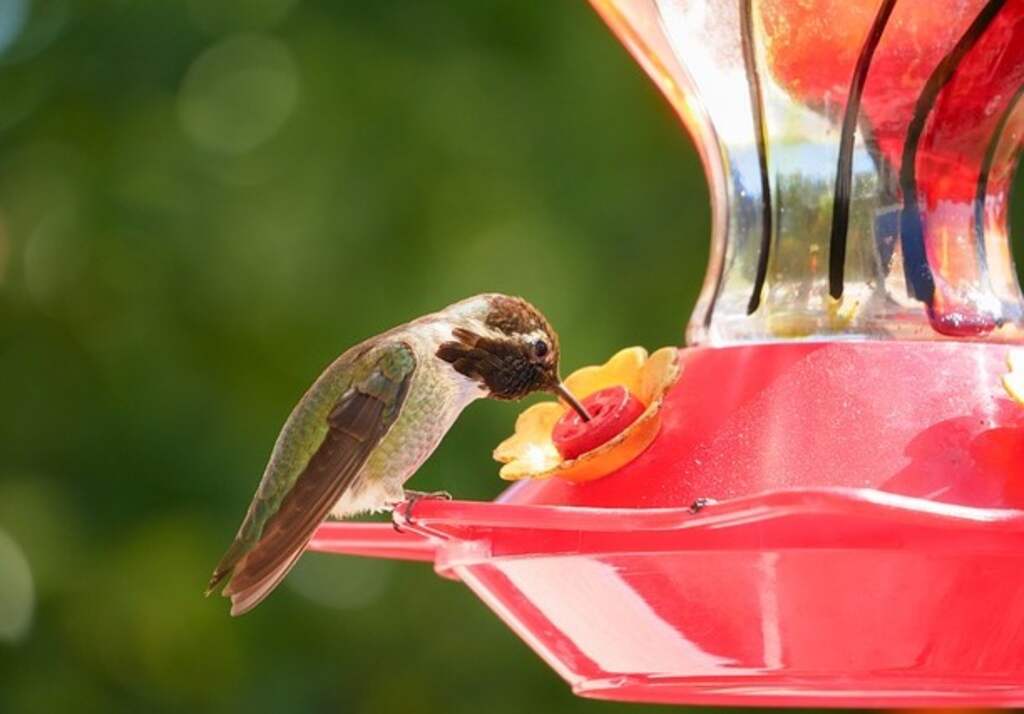Hummingbirds are a joy to watch, but it’s not uncommon to find ants crawling all over their feeders. Ants are attracted to the sweet nectar and can quickly become a nuisance for both the hummingbirds and the feeder owner. Fortunately, there are several effective ways to keep ants away from the feeder and provide an enjoyable experience for the hummingbirds.
Table of Contents
- 1 Key Takeaways:
- 2 How to Keep Ants Off Hummingbird Feeder?
- 3 Understanding the Ant Problem on Hummingbird Feeders
- 4 Choosing an Ant-Proof Hummingbird Feeder
- 5 Proper Placement of the Hummingbird Feeder
- 6 Natural Methods to Repel Ants from Hummingbird Feeders
- 7 Creating Barriers to Prevent Ants
- 8 Regular Cleaning and Maintenance
- 9 Using Ant Traps to Deter Ants
- 10 Observing and Acting Swiftly
- 11 Other Pest Control Measures
- 12 Hummingbird-Friendly Landscaping
- 13 Conclusion
- 14 FAQs: How to Keep Ants Off Hummingbird Feeder
- 14.1 How do I keep ants off my hummingbird feeder?
- 14.2 Why are ants attracted to hummingbird feeders?
- 14.3 How do I choose an ant-proof hummingbird feeder?
- 14.4 Where should I place my hummingbird feeder to prevent ants?
- 14.5 Are there natural methods to repel ants from hummingbird feeders?
- 14.6 How can I create barriers to prevent ants from reaching the hummingbird feeder?
- 14.7 How often should I clean my hummingbird feeder to prevent ant infestations?
- 14.8 Can I use ant traps to deter ants from reaching the hummingbird feeder?
- 14.9 Why is it important to observe and act swiftly if ants are spotted near the feeder?
- 14.10 Are there other pest control measures I can take to keep ants and other pests away from hummingbird feeders?
- 14.11 How can I create a hummingbird-friendly environment through landscaping?
- 15 Author
Key Takeaways:
- Ants are attracted to the sweet nectar in hummingbird feeders, but their presence can disrupt the feeding process.
- It’s important to select an ant-proof hummingbird feeder and properly place it to minimize the chances of ants reaching it.
- Natural remedies and deterrents, as well as creating physical barriers, can help repel ants from the feeder.
- Regular cleaning and maintenance, using ant traps, and observing and acting swiftly at the first signs of ant activity are also effective ways to keep ants off hummingbird feeders.
- Creating a hummingbird-friendly environment through landscaping practices can also help deter ants and other pests.
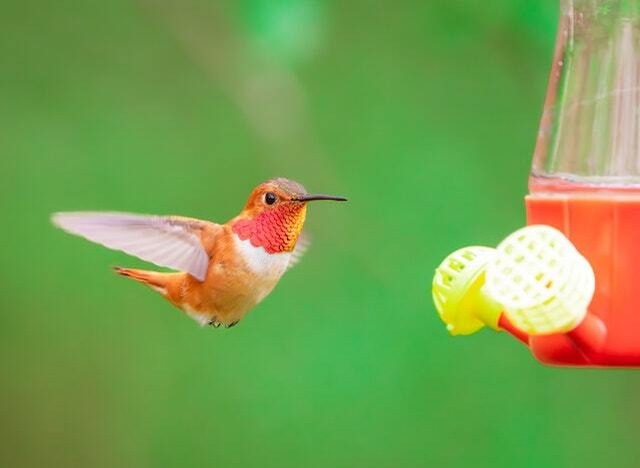
How to Keep Ants Off Hummingbird Feeder?
One effective way to keep ants off a hummingbird feeder is to use an ant moat, which is a small cup filled with water that creates a barrier between the feeder and ants.
Another option is to apply a thin layer of petroleum jelly or cooking oil around the hanger or pole that supports the feeder, as ants are unable to crawl over these substances.
Additionally, keeping the feeder clean and free of spilled nectar can help deter ants from being attracted to the feeder.
Understanding the Ant Problem on Hummingbird Feeders
Ants are notorious for invading hummingbird feeders. They are attracted to the sugar content in the nectar and can quickly overrun the feeding area, scaring off the hummingbirds. Ants can also contaminate the nectar with their bodies, causing it to spoil faster and creating a breeding ground for harmful bacteria.
The presence of ants on a hummingbird feeder can be a frustrating problem for both the birds and their caretakers. Fortunately, there are several effective solutions that can be put in place to prevent ants from accessing the nectar.
Why Ants are Attracted to Hummingbird Feeders
Ants are attracted to the sweet smell of sugar in the hummingbird nectar. They can detect the scent of nectar from a distance and will scout the area for potential food sources. Once they locate the hummingbird feeder, they will leave a trail of pheromones to guide other ants to the source of food.
The presence of ants on a hummingbird feeder can disrupt the feeding process for hummingbirds. Ants crawling on the feeder can scare the birds away, making it difficult for them to access the nectar. Additionally, the ants themselves can contaminate the nectar, making it unfit for consumption and potentially harmful to hummingbirds.
Preventing Ants on Hummingbird Feeders
In order to prevent ants from accessing the nectar, it is important to find effective solutions. This can include selecting an ant-proof feeder, properly positioning the feeder, and utilizing natural remedies and deterrents. It is also important to regularly clean and maintain the feeder to prevent ant infestations.
If ants are spotted on the feeder, it is important to take immediate action to address the issue. This can include physically removing the ants, using ant traps, or creating physical barriers to prevent their access.
By taking the necessary steps to prevent ants from accessing hummingbird feeders, caretakers can ensure a stress-free feeding experience for both the birds and themselves.
Choosing an Ant-Proof Hummingbird Feeder
Hummingbird feeders come in different variations and designs, but not all are created equal. Choosing the right feeder is crucial in keeping ants away from the nectar. Here are some tips to help you select an ant-proof hummingbird feeder:
| Features to Consider | Explanation |
|---|---|
| Sealed Feeding Ports | Opt for a feeder with airtight feeding ports and no open spaces between them. Ants need a continuous trail to reach the nectar, and a sealed feeder prevents them from finding a way in. |
| Feeder Color | Choose feeders in colors that do not attract ants. Red and yellow are the preferred colors for hummingbirds, but they are also known to attract ants. Consider green or clear feeders instead. |
| Built-in Ant Moat | A built-in ant moat is a small reservoir surrounding the feeder that can be filled with water. As ants approach the feeder, they get trapped in the water, preventing them from reaching the nectar. Some feeders come with built-in ant moats, providing an effective solution with minimal effort. |
| Smooth Surface | Choose a feeder with a slippery and smooth surface. Ants cannot grip on a smooth surface and will be deterred from climbing up to the nectar. Feeders made of glass or plastic are ideal. |
| Hang High | Hummingbird feeders should be hung high enough that ants cannot reach them. Consider hanging the feeder from a shepherd’s hook or a tree branch, at least 4-5 feet off the ground, and 10-12 feet away from any structures. |
By considering these features, you can select a feeder that is designed to be ant-proof, providing peace of mind and uninterrupted feeding times for the hummingbirds.
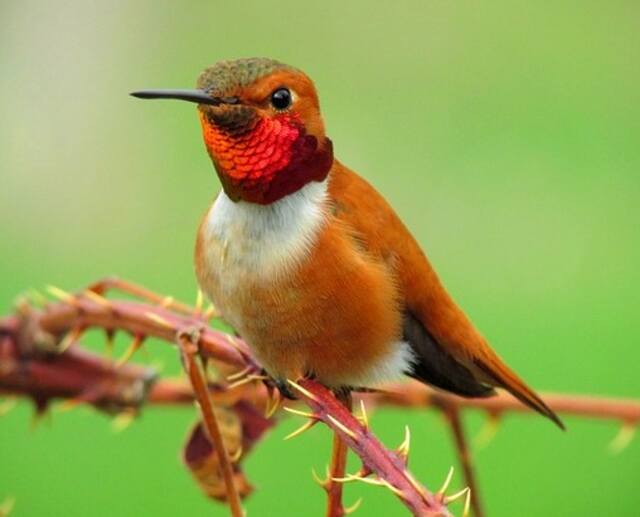
Proper Placement of the Hummingbird Feeder
Placing the hummingbird feeder in the right location is critical in keeping ants away from it. It is essential to keep the feeder away from places where ants can find them easily. Here are some tips to stop ants from invading your hummingbird feeder:
- Hang the feeder from a fixed hook or a wire that ants cannot climb up
- Place the feeder at least 10 feet away from ant trails or trees that hang over or close to the feeder
- Ensure the feeder is not resting on any surfaces that ants can reach, such as fences or branches
- Keep the surrounding area of the feeder clean and free from spilled nectar or any food waste
By following these simple steps, you can significantly reduce the chances of ants finding their way to your hummingbird feeder.
Natural Methods to Repel Ants from Hummingbird Feeders
When it comes to keeping ants away from hummingbird feeders, natural remedies can be just as effective as chemical options, and safer for both hummingbirds and the environment. Here are some of the most popular natural methods to repel ants:
- Cinnamon: Sprinkle cinnamon around the base of the feeder or directly on the nectar. Ants hate the smell and will avoid it.
- Vinegar: Mix equal parts of vinegar and water and spray it around the feeding ports and on the surrounding areas. The acidic smell of vinegar will keep ants away.
- Peppermint Oil: Dilute peppermint oil with water and spray it around the feeder. The strong scent of peppermint is known to repel ants.
- Baby Powder: Dust some baby powder on the hanger or wire connecting the feeder to the hook. Ants won’t cross the powder barrier.
- Bay Leaves: Scatter bay leaves around the feeder or crush them and spread the powder on the feeding ports. Ants dislike the smell of bay leaves.
Remember to keep in mind that natural remedies may need to be reapplied more frequently than chemical options. However, they offer a safer and more eco-friendly alternative to keep pesky ants away from your hummingbird feeder.
Creating Barriers to Prevent Ants
In addition to using an ant-proof hummingbird feeder, creating physical barriers can also be an effective way to keep ants away. By preventing ants from crawling up the feeder or accessing the nectar, you can ensure that hummingbirds have a pest-free feeding experience.
One popular method of creating a barrier is by using an ant moat. These are small plastic cups that attach to the feeder and are filled with water. Ants are unable to swim, so they are unable to reach the nectar.
| Step-by-Step Guide: Using an Ant Moat |
|---|
| 1. Purchase an ant moat that is compatible with your hummingbird feeder. |
| 2. Fill the ant moat with water, making sure the water level is high enough to prevent ants from climbing over the edge. |
| 3. Attach the ant moat between the feeder and the hanging hook or wire. |
| 4. Ensure that the moat is properly secured and that the water level is maintained. |
Another option is to use petroleum jelly as a barrier. Simply apply a small amount of jelly to the hanging wire or hook, creating a slippery surface that will prevent ants from climbing up.
Note: It is important to avoid applying petroleum jelly directly on the feeder or the nectar, as it can be harmful to hummingbirds. Also, be mindful of the weather conditions as high temperatures can cause the jelly to melt and drip onto the feeder.
These methods of creating barriers can be effective in preventing ants from reaching the hummingbird feeder. Keep in mind that it may take some experimentation and adjustments to find the most suitable solution for your feeder and location.
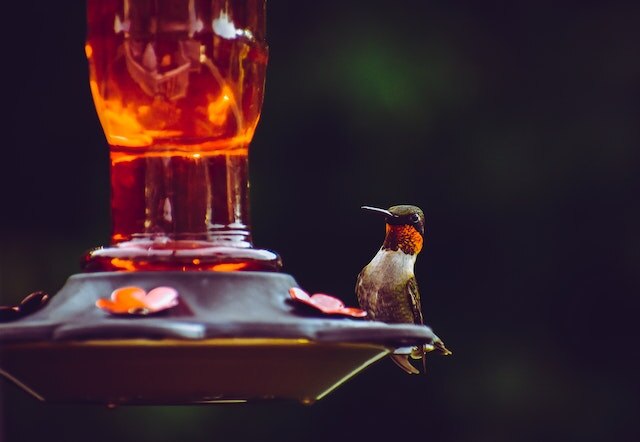
Regular Cleaning and Maintenance
To prevent ant infestations on your hummingbird feeders, it’s crucial to clean and maintain them regularly. Ants are attracted to spilled nectar and sugar deposits on the feeder, so cleaning it often can help keep them away.
As a general rule of thumb, clean the feeder with hot, soapy water every time you refill it. Rinse thoroughly and make sure there’s no residue left behind. If you notice any mold or mildew on the feeder, make a solution of 1 part vinegar to 4 parts water and use it to clean the feeder. Rinse thoroughly afterwards.
It’s also important to replace the nectar every 3-5 days, depending on the weather and how much the birds are feeding. Old nectar can ferment and become a breeding ground for bacteria and other pests, which can lead to ant infestations.
Inspect the feeder regularly for signs of damage or wear and tear. Replace any cracked or damaged parts, as they can create leaks and spills that attract ants.
Using Ant Traps to Deter Ants
If you’ve tried various methods to keep ants off your hummingbird feeder without success, it might be time to consider using ant traps. Ant traps work by luring and trapping ants away from the feeder, preventing them from reaching the nectar.
Ant traps come in different forms, including sticky traps, bait traps, and liquid traps. Sticky traps are the most common type of ant traps and consist of a sticky substance that ants get stuck to when they walk over it.
Bait traps, on the other hand, contain a poisoned bait that ants eat and take back to their colony, ultimately killing the entire ant population. Liquid traps work by attracting ants to a container filled with a sweet liquid that they consume and drown in.
When using ant traps, it’s important to place them strategically around the hummingbird feeder. Place the traps at a distance from the feeder but still close enough to lure ants away from their intended path. Ensure the traps are secure and won’t tip over easily.
Ant traps are effective in deterring ants from reaching the hummingbird feeder, but they require regular maintenance and replacement. Check the traps regularly and replace them when they become full or dry out.
Observing and Acting Swiftly
While prevention is always the best solution, it’s important to remain vigilant for any signs of ant activity around your hummingbird feeder. Early detection is key to addressing the issue before it spirals out of control. Here are a few things to keep in mind:
- Check the feeder regularly: Keep an eye on the feeder every couple of days to ensure no ants are accessing it.
- Observe the behavior of hummingbirds: Often, hummingbirds will avoid feeders that have been infiltrated by ants. Keep an eye on their behavior and look for any signs of ant avoidance.
- Address ant trails immediately: If you spot ant trails leading to the feeder, take immediate steps to address them. Clean up any spilled nectar and consider setting up ant barriers or using natural deterrents.
- Regularly maintain ant barriers: If you’re using ant barriers like moats or petroleum jelly, make sure to check them regularly and refill or reapply them as needed.
By staying vigilant and taking action promptly, you can prevent ant invasions from spoiling your hummingbird feeding experience.
Other Pest Control Measures
In addition to ant control measures, there are other pests that may disrupt hummingbird feeding. Wasps, bees, and other insects can be particularly troublesome. Fortunately, there are several effective pest control measures you can take:
- Use bee guards: Use hummingbird feeders that are designed with bee guards. These plastic barriers keep bees and wasps away from the nectar ports, while still allowing hummingbirds to feed.
- Change nectar frequently: Bees and wasps are attracted to the scent of fermenting nectar. Change the nectar regularly and avoid filling up the feeder completely, leaving some space at the top.
- Hang the feeder higher: Bees and wasps are less likely to bother the feeder if it’s hung at least 10 feet high and away from other feeding stations.
- Provide alternative food sources: Plant flowers that offer an alternative food source for bees and wasps. This may distract them from the hummingbird feeder.
- Use insect traps: Traps designed for wasps and other insects can be effective in reducing their presence around the hummingbird feeder.
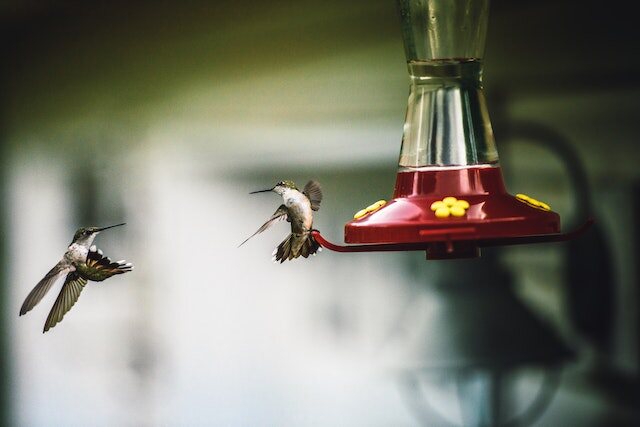
Hummingbird-Friendly Landscaping
Did you know that you can create a hummingbird-friendly environment through strategic landscaping? By planting specific flowers, shrubs, and trees, you can attract hummingbirds while discouraging ants and other pests.
Hummingbirds are attracted to brightly colored flowers, particularly those that are red, pink, orange, or purple. Consider planting flowers such as bee balm, cardinal flower, salvia, and trumpet vine in your garden. These plants not only attract hummingbirds but also provide them with a source of nectar.
In addition to flowers, shrubs such as butterfly bush, lilac, and weigela can also be attractive to hummingbirds. These shrubs provide a place for hummingbirds to perch and rest in between feeding.
Lastly, consider planting trees like dogwood, redbud, and flowering crab apple. Trees like these provide shade, protection, and nesting areas for hummingbirds.
By strategically planting these types of plants, you can create a hummingbird-friendly environment that also helps to prevent ant infestations. Plus, you’ll be able to enjoy the company of these fascinating creatures all season long.
Conclusion
Keeping ants off hummingbird feeders is an essential part of creating an enjoyable feeding experience for hummingbirds. By understanding the ant problem on hummingbird feeders, choosing an ant-proof hummingbird feeder, placing it in the right location, and utilizing natural remedies, barriers, and traps, you can prevent ant infestations.
Remember to observe and act swiftly if ants are spotted, regularly clean and maintain the feeder, and consider additional pest control measures to complement your efforts. Additionally, landscaping with hummingbird-friendly plants can further discourage ants and other pests while attracting more hummingbirds.
We hope the tips and tricks provided in this article will help you create a hassle-free hummingbird feeding experience while keeping ants at bay. Happy birdwatching!

FAQs: How to Keep Ants Off Hummingbird Feeder
How do I keep ants off my hummingbird feeder?
There are several effective tips and tricks to keep ants off your hummingbird feeder. Some methods include choosing an ant-proof hummingbird feeder, properly placing the feeder, using natural remedies like cinnamon or vinegar, creating physical barriers, regular cleaning and maintenance, using ant traps, and observing and acting swiftly when signs of ant activity are spotted.
Why are ants attracted to hummingbird feeders?
Ants are attracted to hummingbird feeders because they are attracted to sweet nectar. Their presence can disrupt the feeding process and can even prevent hummingbirds from accessing the nectar. It is important to find effective solutions to keep ants away from hummingbird feeders.
How do I choose an ant-proof hummingbird feeder?
When selecting a hummingbird feeder, look for features that are designed to be ant-proof. These features may include built-in ant moats, special feeder designs that prevent ants from accessing the nectar, or the ability to attach ant moats or barriers to the feeder.
Where should I place my hummingbird feeder to prevent ants?
To minimize the chances of ants reaching your hummingbird feeder, place it in a location that is away from surfaces where ants can crawl, such as branches, fences, or walls. Hang the feeder from a pole or use hooks to suspend it away from potential ant pathways.
Are there natural methods to repel ants from hummingbird feeders?
Yes, there are natural remedies and deterrents that can be used to repel ants from hummingbird feeders. Some options include sprinkling cinnamon around the feeder, wiping vinegar on surfaces near the feeder, or placing peppermint oil on cotton balls near the feeder.
How can I create barriers to prevent ants from reaching the hummingbird feeder?
To create physical barriers, you can use ant moats, which are small cups filled with water that create a barrier ants cannot cross. Another method is to apply a thin layer of petroleum jelly around the hanger or pole of the feeder to prevent ants from crawling up.
How often should I clean my hummingbird feeder to prevent ant infestations?
It is important to regularly clean and maintain your hummingbird feeder to prevent ant infestations. Clean the feeder every few days or at least once a week, especially during warmer months when ants are more active. Use a solution of hot water and mild soap to clean the feeder and rinse it thoroughly before refilling with fresh nectar.
Can I use ant traps to deter ants from reaching the hummingbird feeder?
Yes, ant traps can be used to deter ants from reaching the hummingbird feeder. There are different types of ant traps available in the market, such as bait stations or liquid ant baits. Follow the instructions provided with the specific ant trap to use it effectively, and place it near the feeder to attract ants away from the feeder.
Why is it important to observe and act swiftly if ants are spotted near the feeder?
It is important to observe any signs of ant activity near the feeder and take immediate action because ants can quickly establish trails and infest the feeder. Acting swiftly can help prevent ants from reaching the nectar and ensure a pleasant feeding experience for hummingbirds.
Are there other pest control measures I can take to keep ants and other pests away from hummingbird feeders?
In addition to the methods mentioned for keeping ants away, there are other pest control measures that can complement your efforts. For example, using wasp or bee guards on the feeder can prevent these insects from accessing the nectar. Keeping the surrounding area clean and free from spilled nectar or debris can also discourage other pests from being attracted to the feeder.
How can I create a hummingbird-friendly environment through landscaping?
You can create a hummingbird-friendly environment through landscaping practices. Planting flowers, shrubs, and trees that produce nectar-rich blooms can attract hummingbirds while discouraging ants and other pests. Some examples of plants that hummingbirds love include trumpet vine, bee balm, and salvia.

